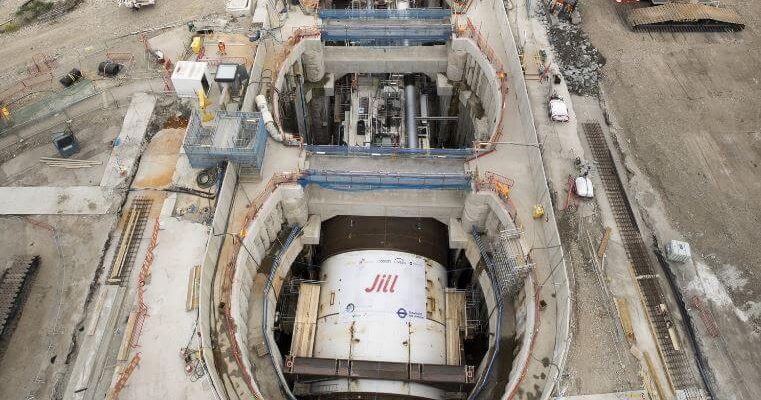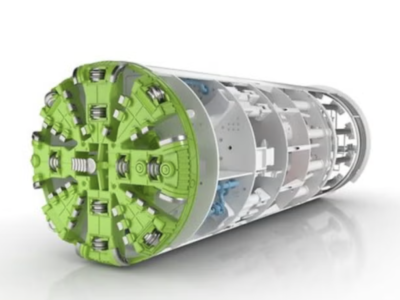
In order to providing the suitable condition of manoeuvre for the massive tunnel boring machine (TBM) digging the Silvertown Tunnel in east London, a peanut launch chamber and a rotation chamber are among have been developed innovations.
According to speech of Silvertown Tunnel project director Juan Angel Martinez at the event on 7 December, the TBM Jill with 1,800t weight and 11.91m length has made the drive so far a bit tricky.
Connecting Newham to the Greenwich Peninsula, excavation process of the 1.4km twin bore road tunnel is due to be done using this machine that is the largest diameter TBM in the UK. The number of rings that is going to be installed by TBM is 1122, while they will be 400mm thick and weigh around 70t.
Following completion of the first tunnel, in order completing to the second tunnel the machine is slated be turned around to head back to Newham.
In 2019, the Silvertown Tunnel design, build, financing, operations and maintenance contract has been granted to the Riverlinx consortium by TfL. The consortium comprises Ferrovial subsidiary Cintra, Bam PPP PGGM, Macquarie Capital, SK E+C and Aberdeen Standard Investments. Also responsibility of completing the design and construction works is up to the Riverlinx Construction Joint Venture, a partnership between Bam Nuttall, Ferrovial Construction and SK Ecoplant.
On 9 December 2022, TBM Jill’s journey was finished beneath the Thames and currently it has reached Greenwich after commissioning from the north side of the river in September. The machine has just a short way to go before it reaches the rotation chamber.
Martinez indicated, considering the shallow depth of the tunnels under the river, as well as the confined conditions of the launch sites on either side of the river, the project team has faced engineering challenges.
Peanut shaft
Planning a TBM launch chamber that would allow the team to both assemble and launch the machine and include all logistics for maintenance of the tunneling operation, was one of the challenges.
In order to starting up the TBM and removing dug material, the shaft needed two openings at the front and back.
The team also needed to innovate a solution to working in compression that would avoid using anchors in the ground due to land right constraints.
“The solution was to design a peanut shaft. This design allowed that team to build the shaft using secant piles – which is the first time in the UK, and possibly the world, for a peanut shaft,” said Martinez.
He also added: “Other alternatives, such as diaphragm walls, were incompatible with the obstructions or with the supply chain. A major benefit of the chosen approach was that it avoided installing anchors.”
While in November 2022, the launch chamber with six 102t, 32m long counterforts, was completed, Riverlinx poured over than 500m3 of concrete to create the chambers.
Rotation chamber
Additionally, in order to enabling the machine to bore the northbound tunnel back towards Silvertown designing a shaft to allow the 180-degree rotation relaunch of the TBM once it reached Greenwich was necessary and the other challenge of this project.
Considering existence of the assets in the vicinity, such as roads and utilities, it was not possible to design a full circle shaped chamber.
Consequently, an elliptical chamber design was developed an implemented by team, whereas it has the ability of maintaining hoop forces even with two openings, one for the TBM tunnels and the other to provide access to the cut and cover tunnel.
A benefit of this approach is that the team has avoided installing anchors that, on top of impacting the acquisition of land constraints, would have required a major diversion of existing utilities, including sewers, potable water pipes and the gas network.
According to Martinez’s explanation about the shaft dimensions and rotation process: “This is a shaft 35m in diameter and 18m deep. The TBM is 12m, so you’ve got 5m on top of the TBM when it arrives for its relaunch.”
He continued: “We are going to hold the TBM like a hovercraft; we are going to turn the TBM and then put it back, and we will launch it with 4% down.”
“The team would be rotating and relaunching the machine very carefully. Everything we are doing, we are planning, we are designing, has to be spot on from the first minute, especially in a PPP [public-private partnership] project. We cannot afford any mistakes,” added Martinez.
















